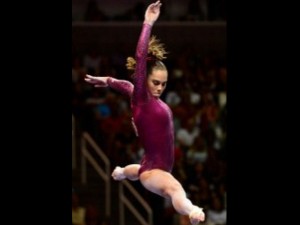
McKayla Maroney competes on the balance beam during day 4 of the 2012 U.S. Olympic Gymnastics Team Trials at HP Pavilion on July 1, 2012 in San Jose, California. AFP FILE PHOTO
LONDON – It’s difficult enough to beat the U.S. women’s gymnastics team these days. Now, the rest of the world will have to try and do it after the Americans are given a head start.
The reigning world champions and heavy gold-medal favorites will begin Sunday’s team qualification on vault, their strongest event, where an injured big toe won’t keep McKayla Maroney from doing her thing.
The 16-year-old will anchor the U.S. on their signature event despite aggravating a toe injury in practice during the run-up to the games.
“Vault is what I’m here for,” Maroney said. “I knew I was going to do vault no matter what.”
And nobody in the world does the difficult Amanar better than the dynamo from Long Beach, Calif., who rocketed to a world title in Tokyo last year while helping the U.S. win the championship by a whopping four points.
The same is expected in London, where the U.S. will attempt to capture Olympic gold for the first time since the “Magnificent Seven” triumphed in Atlanta 16 years ago.
World all-around champion Jordyn Wieber, trials winner Gabby Douglas and team captain Aly Raisman will do all four events for the U.S., with Kyla Ross replacing Maroney on uneven bars, balance beam and floor exercise.
By the time Maroney’s day is over, the U.S. could have a pretty healthy lead. Vault produces the highest scores in competition, and no other country can match the U.S. Amanar for Amanar.
The vault — named after 1996 vault champion Simona Amanar — is arguably the most difficult being done in competition and is worth an extra 0.7 just for even attempting it. If the U.S. executes them cleanly, they’ll put the rest of the 12-team field in a hole that will be tough to overcome.
As if sending a message of their dominance, the U.S. ripped off a series of Amanars during podium training, resembling a pink-clad assembly line.
Barring catastrophe, the U.S. will be one of the eight teams to advance to Tuesday night’s finals.
Each team enters four athletes per event during qualifying, with the three best scores counting.
The top eight teams at the end of the night make the finals on Tuesday, which moves to the “three-up, three-count” format.
The stiffest test for the U.S. is expected to come from defending Olympic champion China, Russia and a resurgent Romanian squad that won the European championships this spring.
Still, there’s little doubt the U.S. is the team to catch, particularly with Maroney in the lineup.
Eyebrows were raised just before the games when she was held out for much of training, spending time behind a small protective wall with her feet hidden from view.
She’d accidentally kicked a beam during practice shortly after the U.S. arrived in London, causing her big toe, which she broke at a competition in Chicago in May, to start throbbing again.
The only real treatment is time off. She won’t get any until after the games and will grit her way through the vault with her big toe and second toe taped together.
After she’s done with her two trips down the runway, Maroney will get a close-up view of the budding rivalry between Wieber and Douglas.
Wieber has steamrolled the competition for the past three years but was upended by the sprightly Douglas at trials. Both have stressed they’re focused on the team gold, but the qualification round will mark the start of what could be a gripping week in which the U.S. tries to repeat the 1-2 all-around finish produced four years ago by Nastia Liukin and Shawn Johnson.
If Douglas or Wieber falters, Raisman is more than capable of bumping one out of the all-around. The top 24 individual finishers move on to the finals Thursday, but Olympic rules allow only two athletes from any country to advance, meaning at least one of the three Americans will watch from the stands.
It’s that kind of depth that has made the U.S. a prohibitive favorite. Wieber, Douglas, Maroney and Raisman were all part of the world championship team that crushed the field in Tokyo. The 15-year-old Ross has fit right in, her elegant lines a marked contrast in style to some of her more muscled teammates.
Ross has hardly been intimidated by the stage, soaring at trials last month to finish second on bars behind Douglas. She was sharp in training on Friday, earning praise from team coordinator Martha Karolyi after a series of no-wobble beam routines.
A repeat performance Sunday should set the stage for the biggest night in U.S. gymnastics this millennium.